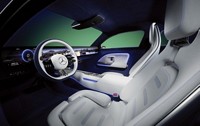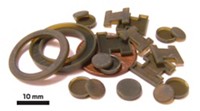Advertisement
Grab your lab coat. Let's get started
Welcome!
Welcome!
Create an account below to get 6 C&EN articles per month, receive newsletters and more - all free.
It seems this is your first time logging in online. Please enter the following information to continue.
As an ACS member you automatically get access to this site. All we need is few more details to create your reading experience.
Not you? Sign in with a different account.
Not you? Sign in with a different account.
ERROR 1
ERROR 1
ERROR 2
ERROR 2
ERROR 2
ERROR 2
ERROR 2
Password and Confirm password must match.
If you have an ACS member number, please enter it here so we can link this account to your membership. (optional)
ERROR 2
ACS values your privacy. By submitting your information, you are gaining access to C&EN and subscribing to our weekly newsletter. We use the information you provide to make your reading experience better, and we will never sell your data to third party members.
Materials
Smithsonian Exhibit Celebrates the Design of High-performance Materials
by VICTORIA GILMAN
August 1, 2005
| A version of this story appeared in
Volume 83, Issue 31
OUTREACH
You don't often hear someone liken tire cord fabric to the folds of an evening gown.
This unusual connection was first made in 1956 by Arthur Drexler, past director of the Museum of Modern Art (MoMA), in a catalog entry about the industrial fabrics portion of the museum's exhibit, "Textiles USA."
Several years later, MoMA employee Matilda McQuaid read Drexler's poetic comparison and was intrigued by the role of design in advanced materials. Now head of textiles at the Smithsonian's Cooper-Hewitt National Design Museum in New York City, McQuaid has used that inspiration to assemble an entire exhibit on the form and function of high-tech fabrics.
Titled "Extreme Textiles," the exhibit opened at the Cooper-Hewitt in April and will run through October. Featured materials run the gamut from knotless polyester fishing nets to a BMW Formula 1 race car made almost entirely from carbon/epoxy composites.
"Innovation, functionality, and beauty were my criteria for this exhibit," McQuaid explains.
The show highlights nearly 150 examples of high-performance textiles that are, according to Cooper-Hewitt Director Paul W. Thompson, "among the most exciting and radical expressions of design today."
In conjunction with the exhibit, Cooper-Hewitt organized a symposium in May on the intersection of science and design that gave rise to the products sharing space on the museum floor. Keynote speakers Benjamin Chu and Benjamin S. Hsiao from the State University of New York, Stony Brook, chemistry department, kicked off the event with a presentation on nanofibers, which are used in several of the museum's exhibits.
Chu and Hsiao focused specifically on the electrospinning process for creating nanofibers. In this technique, a charged polymeric solution is drawn out of a small opening toward a grounded collection plate. As the thin stream leaves the opening, the solvent evaporates in midair, leaving solid threads that can range between 10 and 100 nm in diameter.
"Three grams of polymer would spin a 100-nm fiber long enough to reach from Earth to the moon," Chu said.
More than 600 papers on electrospinning have been published during the past four years, he noted, carving paths for a variety of applications.
For example, Chu and Hsiao described work they published this year in the journal Biomaterials as part of a team of researchers developing a bandage for heart cell regeneration. Using electrospinning, the team created a patch of nonwoven, bioabsorbable poly(lactide)- and poly(glycolide)-based nanofibers that mimic the scaffolding of heart tissue to support cell growth.
In addition to medical applications, Hsiao described possible futures for electrospun nanofibers in water filtration, sensors, and liquid-crystal displays.
Researchers and entrepreneurs who donated samples for the exhibit spoke about some of their more unusual designs. Two talks--one on electronic textiles and the other on architecture--covered uses from health care to sports to home decor and fashion.
Robert F. Kinney of the U.S. Army Natick Soldier Center talked about using e-textiles to meet challenges faced by troops in remote locations. "A soldier carrying the bare essentials has about 80 lb of gear" right now, he said. And in today's high-tech military, that includes lots of electronics.
"They're probably using more AA batteries than ammo," Kinney quipped. Among the Natick-developed prototypes that McQuaid displayed is an e-textile vest that serves as a wearable broadband antenna, cutting down on the heavy radio equipment and tangled masses of cables that soldiers must lug around.
Perhaps the most memorable displays in "Extreme Textiles" are of items already in commercial use that don't conform to a traditional notion of fabrics. Sailboat hulls, rocket engine parts, and even a model of a 40-story tower all find a place in the Cooper-Hewitt exhibit.
Taken together, the futuristic and the mundane deliver a powerful message: High-performance textiles are an important--and often surprising--part of everyday life.
MORE ON THIS STORY





Join the conversation
Contact the reporter
Submit a Letter to the Editor for publication
Engage with us on Twitter